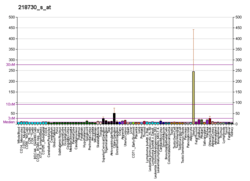Osteoglycin
Osteoglycin (also called mimecan), encoded by the OGN gene, is a human protein.[5]
This gene encodes a protein which induces ectopic bone formation in conjunction with transforming growth factor beta. This protein is a small proteoglycan which contains tandem leucine-rich repeats (LRR). The gene expresses three transcript variants.[5]
The level of expression of this gene has been correlated with enlarged hearts and more specifically left ventricular hypertrophy.[6][7]
References
- 1 2 3 GRCh38: Ensembl release 89: ENSG00000106809 - Ensembl, May 2017
- 1 2 3 GRCm38: Ensembl release 89: ENSMUSG00000021390 - Ensembl, May 2017
- ↑ "Human PubMed Reference:".
- ↑ "Mouse PubMed Reference:".
- 1 2 "Entrez Gene: OGN osteoglycin".
- ↑ "Big hearts 'have genetic problem'". Health. BBC News. 2008-06-06. Retrieved 2008-06-07.
- ↑ Petretto E, Sarwar R, Grieve I, Lu H, Kumaran MK, Muckett PJ, Mangion J, Schroen B, Benson M, Punjabi PP, Prasad SK, Pennell DJ, Kiesewetter C, Tasheva ES, Corpuz LM, Webb MD, Conrad GW, Kurtz TW, Kren V, Fischer J, Hubner N, Pinto YM, Pravenec M, Aitman TJ, Cook SA (May 2008). "Integrated genomic approaches implicate osteoglycin (Ogn) in the regulation of left ventricular mass". Nat. Genet. 40 (5): 546–52. doi:10.1038/ng.134. PMC 2742198. PMID 18443592.
Further reading
- Kukita A, Bonewald L, Rosen D, et al. (1990). "Osteoinductive factor inhibits formation of human osteoclast-like cells". Proc. Natl. Acad. Sci. U.S.A. 87 (8): 3023–6. doi:10.1073/pnas.87.8.3023. PMC 53826. PMID 2326263.
- Madisen L, Neubauer M, Plowman G, et al. (1990). "Molecular cloning of a novel bone-forming compound: osteoinductive factor". DNA Cell Biol. 9 (5): 303–9. doi:10.1089/dna.1990.9.303. PMID 2372374.
- Tasheva ES, Funderburgh ML, McReynolds J, et al. (1999). "The bovine mimecan gene. Molecular cloning and characterization of two major RNA transcripts generated by alternative use of two splice acceptor sites in the third exon". J. Biol. Chem. 274 (26): 18693–701. doi:10.1074/jbc.274.26.18693. PMID 10373482.
- Matsushima N, Ohyanagi T, Tanaka T, Kretsinger RH (2000). "Super-motifs and evolution of tandem leucine-rich repeats within the small proteoglycans--biglycan, decorin, lumican, fibromodulin, PRELP, keratocan, osteoadherin, epiphycan, and osteoglycin". Proteins. 38 (2): 210–25. doi:10.1002/(SICI)1097-0134(20000201)38:2<210::AID-PROT9>3.0.CO;2-1. PMID 10656267.
- Pellegata NS, Dieguez-Lucena JL, Joensuu T, et al. (2000). "Mutations in KERA, encoding keratocan, cause cornea plana". Nat. Genet. 25 (1): 91–5. doi:10.1038/75664. PMID 10802664.
- Tasheva ES, Pettenati M, Von Kap-Her C, Conrad GW (2000). "Assignment of mimecan gene (OGN) to human chromosome band 9q22 by in situ hybridization". Cytogenet. Cell Genet. 88 (3–4): 326–7. doi:10.1159/000015521. PMID 10828622.
- Hu RM, Han ZG, Song HD, et al. (2000). "Gene expression profiling in the human hypothalamus-pituitary-adrenal axis and full-length cDNA cloning". Proc. Natl. Acad. Sci. U.S.A. 97 (17): 9543–8. doi:10.1073/pnas.160270997. PMC 16901. PMID 10931946.
- Hartley JL, Temple GF, Brasch MA (2001). "DNA Cloning Using In Vitro Site-Specific Recombination". Genome Res. 10 (11): 1788–95. doi:10.1101/gr.143000. PMC 310948. PMID 11076863.
- Wiemann S, Weil B, Wellenreuther R, et al. (2001). "Toward a Catalog of Human Genes and Proteins: Sequencing and Analysis of 500 Novel Complete Protein Coding Human cDNAs". Genome Res. 11 (3): 422–35. doi:10.1101/gr.GR1547R. PMC 311072. PMID 11230166.
- Simpson JC, Wellenreuther R, Poustka A, et al. (2001). "Systematic subcellular localization of novel proteins identified by large-scale cDNA sequencing". EMBO Rep. 1 (3): 287–92. doi:10.1093/embo-reports/kvd058. PMC 1083732. PMID 11256614.
- Strausberg RL, Feingold EA, Grouse LH, et al. (2003). "Generation and initial analysis of more than 15,000 full-length human and mouse cDNA sequences". Proc. Natl. Acad. Sci. U.S.A. 99 (26): 16899–903. doi:10.1073/pnas.242603899. PMC 139241. PMID 12477932.
- Tasheva ES, Conrad GW (2003). "The UV responsive elements in the human mimecan promoter: a functional characterization". Mol. Vis. 9: 1–9. PMID 12533723.
- Luijendijk MW, van de Pol TJ, van Duijnhoven G, et al. (2004). "Cloning, characterization, and mRNA expression analysis of novel human fetal cochlear cDNAs". Genomics. 82 (4): 480–90. doi:10.1016/S0888-7543(03)00150-2. PMID 13679028.
- Humphray SJ, Oliver K, Hunt AR, et al. (2004). "DNA sequence and analysis of human chromosome 9". Nature. 429 (6990): 369–74. doi:10.1038/nature02465. PMC 2734081. PMID 15164053.
- Zhang Z, Henzel WJ (2005). "Signal peptide prediction based on analysis of experimentally verified cleavage sites". Protein Sci. 13 (10): 2819–24. doi:10.1110/ps.04682504. PMC 2286551. PMID 15340161.
- Gerhard DS, Wagner L, Feingold EA, et al. (2004). "The Status, Quality, and Expansion of the NIH Full-Length cDNA Project: The Mammalian Gene Collection (MGC)". Genome Res. 14 (10B): 2121–7. doi:10.1101/gr.2596504. PMC 528928. PMID 15489334.
- Wiemann S, Arlt D, Huber W, et al. (2004). "From ORFeome to Biology: A Functional Genomics Pipeline". Genome Res. 14 (10B): 2136–44. doi:10.1101/gr.2576704. PMC 528930. PMID 15489336.
- Hu SM, Li F, Yu HM, et al. (2006). "The mimecan gene expressed in human pituitary and regulated by pituitary transcription factor-1 as a marker for diagnosing pituitary tumors". J. Clin. Endocrinol. Metab. 90 (12): 6657–64. doi:10.1210/jc.2005-0322. PMID 16189248.
- Otsuki T, Ota T, Nishikawa T, et al. (2007). "Signal sequence and keyword trap in silico for selection of full-length human cDNAs encoding secretion or membrane proteins from oligo-capped cDNA libraries". DNA Res. 12 (2): 117–26. doi:10.1093/dnares/12.2.117. PMID 16303743.
- Mehrle A, Rosenfelder H, Schupp I, et al. (2006). "The LIFEdb database in 2006". Nucleic Acids Res. 34 (Database issue): D415–8. doi:10.1093/nar/gkj139. PMC 1347501. PMID 16381901.
This article is issued from
Wikipedia.
The text is licensed under Creative Commons - Attribution - Sharealike.
Additional terms may apply for the media files.




